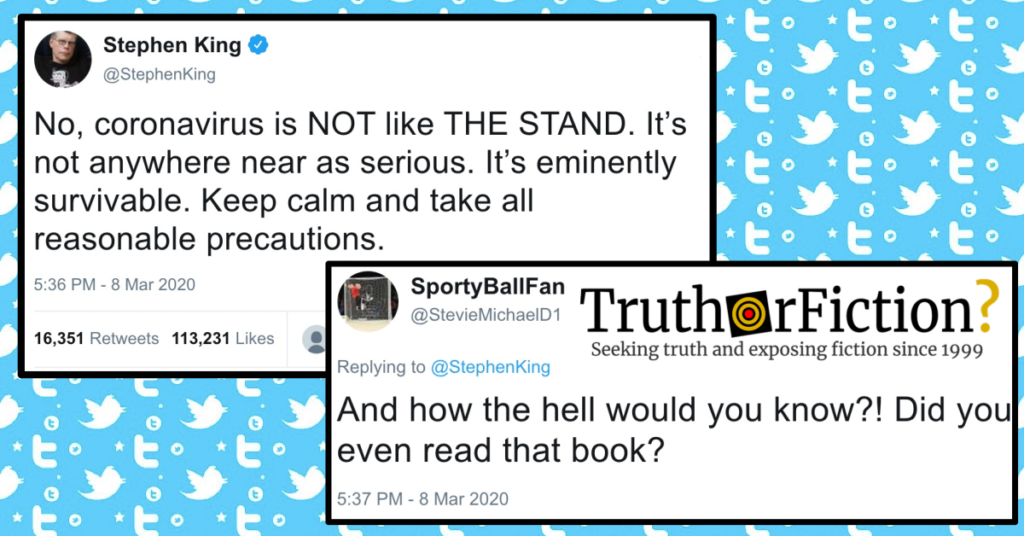On March 11 2020, Facebook page “The Other 98%” shared a screenshot of a popular Twitter exchange between author Stephen King and another Twitter user, during which King denied the COVID-19 global pandemic was “like The Stand,” and a person replied to ask King if he “had even read” that book:
Social media users likely encountered comparisons between coronavirus strain COVID-19 and the “superflu,” also known as “Captain Trips,” from Stephen King’s 1978 novel The Stand (or the subsequent popular miniseries adaptation aired on network television in 1994) during the 2020 pandemic. The Stand was a memorable entry in the horror sub-genre of epidemiological thrillers, although its core virus had a staggering mortality rate of 99.4 percent.
On March 8 2020, King — presumably tired of hearing comparisons between COVID-19 and the events of The Stand — tweeted that the spread of the COVID-19 strain of coronavirus was “eminently survivable,” and referenced his novel:
King noted that COVID-19 was not “anywhere near as serious” as The Stand‘s superflu; while known information about novel coronavirus was in flux, new research was published on a daily basis in medical journals globally. Research published on March 12 2020 in The Lancet (“Real estimates of mortality following COVID-19 infection”) noted that an often-referenced mortality rate between three and four percent might “underestimate the potential threat of COVID-19 in symptomatic patients.”
Researchers further reported that updated knowledge about COVID-19’s trajectory in patients showed that the time between symptom onset and death “ranged from about 2 weeks to 8 weeks”:
As of March 1, 2020, 79 968 patients in China and 7169 outside of China had tested positive for coronavirus disease 2019 (COVID-19). Among Chinese patients, 2873 deaths had occurred, equivalent to a mortality rate of 3·6% (95% CI 3·5–3·7), while 104 deaths from COVID-19 had been reported outside of China (1·5% [1·2–1·7]). However, these mortality rate estimates are based on the number of deaths relative to the number of confirmed cases of infection, which is not representative of the actual death rate; patients who die on any given day were infected much earlier, and thus the denominator of the mortality rate should be the total number of patients infected at the same time as those who died. Notably, the full denominator remains unknown because asymptomatic cases or patients with very mild symptoms might not be tested and will not be identified. Such cases therefore cannot be included in the estimation of actual mortality rates, since actual estimates pertain to clinically apparent COVID-19 cases….
The later research proposed a mortality rate possibly between five and six percent — higher than the 3.4 percent case-fatality rate often cited, but significantly lower than the 99.4 percent rate King wrote about in The Stand:
We re-estimated mortality rates by dividing the number of deaths on a given day by the number of patients with confirmed COVID-19 infection 14 days before. On this basis, using WHO data on the cumulative number of deaths to March 1, 2020, mortality rates would be 5·6% (95% CI 5·4–5·8) for China and 15·2% (12·5–17·9) outside of China. Global mortality rates over time using a 14-day delay estimate are shown in the figure, with a curve that levels off to a rate of 5·7% (5·5–5·9), converging with the current WHO estimates. Estimates will increase if a longer delay between onset of illness and death is considered. A recent time-delay adjusted estimation indicates that mortality rate of COVID-19 could be as high as 20% in Wuhan, the epicentre of the outbreak. These findings show that the current figures might underestimate the potential threat of COVID-19 in symptomatic patients.
Going back to King’s tweet observing that COVID-19 was nothing like the virus in The Stand, a fellow Twitter user responded:
And how the hell would you know?! Did you even read that book?
Screenshots of the tweets together were popular because, of course, King wrote The Stand. However, the same user’s account appeared to be used exclusively for “trolling” other Twitter users, and responses across that specific timeline were entirely sarcastic in nature — repeatedly further baiting people taking the tweet seriously to clarify the difference between having read something and having written it:
But did he READ it? Writing and reading are two entirely different exercises. I think even a Historian like Mr. King would agree!
It is true Stephen King tweeted on March 8 2020 that novel coronavirus strain COVID-19 was unlike the virus in his epidemiology horror novel The Stand, and further true that a widely-shared reply concerned whether King had “even read” the book he authored. Most commenters on shares appeared to believe the response was sincere, but it was taken out of context from a troll account devoted solely to baiting Twitter users into silly and pointless debates.

